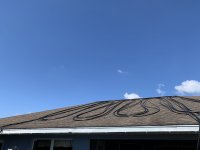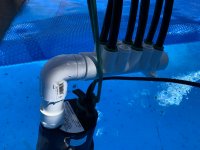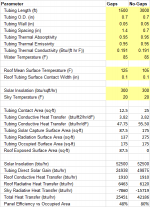I know this is heavily debated around here with the usual consensus that professional solar panels give you more bang for the buck but that isn't what I'm seeing now that prices are skyrocketing.
Cheapest panels I see on ebay are $130 for 2'x20'. There is only one company offering that price, most I see are twice that price so I'm a bit hesitant as to quality, etc. PVC and connectors are going to easily add an additional $100-$150. And in my town we need a permit to install solar panels. so no idea of those fees ($100+?).
So I bought three 500' lengths of 1/2 inch tubing on amazon for $40 each and a submersible pump for $45. PVC connectors for the pump were another $20. So $185 total for about 60 square feet of solar surface area.
First I tried just running 500' of hose around on the grass. I got about 5000 btu at noon on a sunny day.
Then I tried 500' in one of those hot boxes they make on youtube and got about 7000 btu at noon on a sunny day. Better, but still no buano.
Then I split the hose in half (2x250') and ran that through the hot box and got 8500 btu.
Then I split another spool and ran both halves back and forth across the roof and got 17k btu!! Why you ask? My roof and attic are very hot during the day so it's getting a ton of conduction heat in addition to the direct solar energy. That said I decided to run the other spools on the roof as well.
So for $185 (and a bunch of time and effort) I'm getting around 50k btu/h into my little 4000 gallon AGP (at noon on a sunny day). My pool was averaging around 71 degrees (here in Florida), now it's almost 90. Love it.
If anyone else wants to try, here's some things I learned:
For all the irrigation tube "nay-sayers" here's what I think you are overlooking with the tubing. Many of you guys are simply calculating potential btu based on direct solar energy hitting the surface of the tube. But you guys seem to be ignoring the conductive heat the hose picks up from whatever surface it's touching. Those "hot boxes" (I call them) are even more efficient because they use the greenhouse effect and also block wind so less heat escapes into the air. (They get hot inside like your car does parked outside on a sunny day). That said the cheapest crappiest 3/8" plywood I could find was like $30 so it's more cost effective (and easier) to just add more pipe. I guess a box could be made with old pallets or something but that's too much effort.
As for the math: My return tubes fill a 5 gallon bucket in 19.5 seconds so I'm getting about 15 gpm and a 7f degree rise from intake to outflow.
btu/h = 15 x 7 x 8.2 x 60
Cheapest panels I see on ebay are $130 for 2'x20'. There is only one company offering that price, most I see are twice that price so I'm a bit hesitant as to quality, etc. PVC and connectors are going to easily add an additional $100-$150. And in my town we need a permit to install solar panels. so no idea of those fees ($100+?).
So I bought three 500' lengths of 1/2 inch tubing on amazon for $40 each and a submersible pump for $45. PVC connectors for the pump were another $20. So $185 total for about 60 square feet of solar surface area.
First I tried just running 500' of hose around on the grass. I got about 5000 btu at noon on a sunny day.
Then I tried 500' in one of those hot boxes they make on youtube and got about 7000 btu at noon on a sunny day. Better, but still no buano.
Then I split the hose in half (2x250') and ran that through the hot box and got 8500 btu.
Then I split another spool and ran both halves back and forth across the roof and got 17k btu!! Why you ask? My roof and attic are very hot during the day so it's getting a ton of conduction heat in addition to the direct solar energy. That said I decided to run the other spools on the roof as well.
So for $185 (and a bunch of time and effort) I'm getting around 50k btu/h into my little 4000 gallon AGP (at noon on a sunny day). My pool was averaging around 71 degrees (here in Florida), now it's almost 90. Love it.
If anyone else wants to try, here's some things I learned:
- Don't bother with the hot box idea if you have a hot roof.
- The hot box cost $50+ plus time and effort to build. For that cost it would have been better to simply buy more tubing and run it across the grass.
- Cut the 500' rolls in half (250'), to get twice the gpm and more overall btu. (Yes I have six 250' tubes running from the pump, across my roof, and back into the pool).
- Don't spiral up the hoses. This causes slower water flow. Water moves fastest in a straight line.
- Put gaps between the hoses on the roof and don't let them overlap. Most of the heat is coming from the hose touching the roof. If hoses are placed too tightly together, it will make a cold spot in the roof and you won't get as much benefit from the heat of the roof.
- They make a pvc fitting called a manifold (normally used for spa jets). I connected it to the pump and used slip compression inserts to connect the tubing.
- Don't wear running shoes on a hot roof, the sole glue melts after a bit.
- Have two ladders at different ends of the house in case you knock your ladder down while pulling all that tubing up to the roof (or take your phone with you so you can call someone to set your ladder back up lol)
For all the irrigation tube "nay-sayers" here's what I think you are overlooking with the tubing. Many of you guys are simply calculating potential btu based on direct solar energy hitting the surface of the tube. But you guys seem to be ignoring the conductive heat the hose picks up from whatever surface it's touching. Those "hot boxes" (I call them) are even more efficient because they use the greenhouse effect and also block wind so less heat escapes into the air. (They get hot inside like your car does parked outside on a sunny day). That said the cheapest crappiest 3/8" plywood I could find was like $30 so it's more cost effective (and easier) to just add more pipe. I guess a box could be made with old pallets or something but that's too much effort.
As for the math: My return tubes fill a 5 gallon bucket in 19.5 seconds so I'm getting about 15 gpm and a 7f degree rise from intake to outflow.
btu/h = 15 x 7 x 8.2 x 60
- gpm=15
- delta T = 7
- weight / gallon 8.2
- minutes / hour = 60





